Application of Chemostratigraphic Methods to Floodplain Alluvial Deposits within the Big Harris Creek Basin, North Carolina
Abstract
:1. Introduction
2. Materials and Methods
2.1. Study Area
2.2. Stratigraphic Analyses
2.3. Sediment Sampling
2.4. Analysis of Grain Size Distribution
2.5. Analytical Metal Analyses
2.6. Selection of Elements for Chemostratigraphic Analysis
3. Results and Discussion
3.1. Lithologic Characteristics of the Floodplain
3.2. Defining, Characterizing, and Correlating Chemostratigraphic Units
3.3. Comparison of Chemo- and Lithostratigraphic Units
3.4. Implications of Chemostratigraphic Correlations to Depositional Processes
4. Summary and Conclusions
Supplementary Materials
Author Contributions
Funding
Data Availability Statement
Acknowledgments
Conflicts of Interest
References
- Macklin, M.G.; Brewer, P.A.; Hudson-Edwards, K.A.; Bird, G.; Coulthard, T.J.; Dennis, I.A.; Lechler, P.J.; Miller, J.R.; Turner, J.N. A Geomorphological Approach to the Management of Rivers Contaminated by Metal Mining. Geomorphology 2006, 79, 423–447. [Google Scholar] [CrossRef]
- Macklin, M.G.; Lewin, J. Alluvial Responses to the Changing Earth System. Earth Surf. Process. Landf. 2008, 33, 1374–1395. [Google Scholar] [CrossRef]
- Swennen, R.; Van der Sluys, J. Anthropogenic Impact on Sediment Composition and Geochemistry in Vertical Overbank Profiles of River Alluvium from Belgium and Luxembourg. J. Geochem. Explor. 2002, 75, 93–105. [Google Scholar] [CrossRef]
- de Moor, J.J.W.; Kasse, C.; van Balen, R.; Vandenberghe, J.; Wallinga, J. Human and Climate Impact on Catchment Development during the Holocene—Geul River, the Netherlands. Geomorphology 2008, 98, 316–339. [Google Scholar] [CrossRef]
- Dearman, T.L.; James, L.A. Patterns of Legacy Sediment eposits in a Small South Carolina Piedmont Catchment, USA. Geomorphology 2019, 343, 1–14. [Google Scholar] [CrossRef]
- Allan James, L.; Beach, T.P.; Richter, D.D. Floodplain and Terrace Legacy Sediment as a Widespread Record of Anthropogenic Geomorphic Change. Ann. Am. Assoc. Geogr. 2021, 111, 742–755. [Google Scholar] [CrossRef]
- Trimble, S.W.; Happ, S.C.; Rittenhouse, G.; Dobson, G.C. 1940: Some Principles of Accelerated Stream and Valley Sedimentation. US Department of Agriculture Technical Bulletin 695. Prog. Phys. Geogr. 2008, 32, 337–345. [Google Scholar] [CrossRef]
- Knox, J.C. Valley Alluviation in Southwestern Wisconsin. Ann. Am. Assoc. Geogr. 1972, 62, 401–410. [Google Scholar] [CrossRef]
- Knox, J.C. Historical Valley Floor Sedimentation in the Upper Mississippi Valley. Ann. Am. Assoc. Geogr. 1987, 77, 224–244. [Google Scholar] [CrossRef]
- Knox, J.C. Floodplain Sedimentation in the Upper Mississippi Valley: Natural versus Human Accelerated. Geomorphology 2006, 79, 286–310. [Google Scholar] [CrossRef]
- Jacobson, R.B.; Coleman, D.J. Stratigraphy and Recent Evolution of Maryland Piedmont Flood Plains. Am. J. Sci. 1986, 286, 617. [Google Scholar] [CrossRef]
- Beach, T. The Fate of Eroded Soil: Sediment Sinks and Sediment Budgets of Agrarian Landscapes in Southern Minnesota, 1851–1988. Ann. Am. Assoc. Geogr. 1994, 84, 5–28. [Google Scholar] [CrossRef]
- Leigh, D.S. Mercury-Tainted Overbank Sediment from Past Gold Mining in North Georgia, USA. Environ. Geol. 1997, 30, 244–251. [Google Scholar] [CrossRef]
- Beach, T.; Luzzadder-Beach, S.; Cook, D.; Dunning, N.; Kennett, D.J.; Krause, S.; Terry, R.; Trein, D.; Valdez, F. Ancient Maya Impacts on the Earth’s Surface: An Early Anthropocene Analog? Quat. Sci. Rev. 2015, 124, 1–30. [Google Scholar] [CrossRef] [Green Version]
- Hooke, R.L. On the History of Humans as Geomorphic Agents. Geology 2000, 28, 843–846. [Google Scholar] [CrossRef]
- Wilkinson, B.H.; McElroy, B.J. The Impact of Humans on Continental Erosion and Sedimentation. GSA Bull. 2007, 119, 140–156. [Google Scholar] [CrossRef]
- James, L.A. Legacy Sediment: Definitions and Processes of Episodically Produced Anthropogenic Sediment. Anthropocene 2013, 2, 16–26. [Google Scholar] [CrossRef]
- Gilbert, G.K. Hydrualic-Mining Debris in the Sierra Nevada; United States Geological Survey: Washington, DC, USA, 1917. [Google Scholar]
- Miller, J.R.; Lechler, P.J.; Desilets, M. The Role of Geomorphic Processes in the Transport and Fate of Mercury in the Carson River Basin, West-Central Nevada. Environ. Geol. 1998, 33, 249–262. [Google Scholar] [CrossRef]
- Lecce, S.A. Spatial Patterns of Historical Overbank Sedimentation and Floodplain Evolution, Blue River, Wisconsin. Geomorphology 1997, 18, 265–277. [Google Scholar] [CrossRef]
- Orbock Miller, S.M.; Ritter, D.F.; Kochel, R.C.; Miller, J.R. Fluvial Responses to Land-Use Changes and Climatic Variations within the Drury Creek Watershed, Southern Illinois. Geomorphology 1993, 6, 309–329. [Google Scholar] [CrossRef]
- Schenk, E.R.; Hupp, C.R. Legacy Effects of Colonial Millponds on Floodplain Sedimentation, Bank Erosion, and Channel Morphology, Mid-Atlantic, USA1. JAWRA J. Am. Water Resour. Assoc. 2009, 45, 597–606. [Google Scholar] [CrossRef]
- Walter, R.C.; Merritts, D.J. Natural Streams and the Legacy of Water-Powered Mills. Science 2008, 319, 299–304. [Google Scholar] [CrossRef] [PubMed] [Green Version]
- Fleming, P.M.; Merritts, D.J.; Walter, R.C. Legacy Sediment Erosion Hot Spots: A Cost-Effective Approach for Targeting Water Quality Improvements. J. Soil Water Conserv. 2019, 74, 67A. [Google Scholar] [CrossRef] [Green Version]
- Wegmann, K.W.; Lewis, R.Q.; Hunt, M.C. Historic Mill Ponds and Piedmont Stream Water Quality: Making the Connection near Raleigh, North Carolina; Field Guide 29; Geological Society of America: Boulder, CO, USA, 2012. [Google Scholar]
- Donovan, M.; Miller, A.; Baker, M.; Gellis, A. Sediment Contributions from Floodplains and Legacy Sediments to Piedmont Streams of Baltimore County, Maryland. Geomorphology 2015, 235, 88–105. [Google Scholar] [CrossRef]
- Happ, S.C. Sedimentation in South Carolina Piedmont Valleys. Am. J. Sci. 1945, 243, 113. [Google Scholar] [CrossRef]
- Happ, S.C.; Rittenhouse, G.; Dobson, G.C. Some Principles of Accelerated Stream and Valley Sedimentation, General Technical Bulletin 105. 1940. Available online: https://www.yumpu.com/en/document/view/17676383/some-principles-of-accelerated-stream-and-valley-sedimentation (accessed on 24 April 2022).
- Trimble, S.W. Man-Induced Soil Erosion on the Southern Piedmont, 1700-1970; Soil and Water Conservation Society of America: Ankeny, IA, USA, 1974. [Google Scholar]
- Miller, J.R.; Grow, D.; Philyaw, L.S. Influence of Historical Land-Use Change on Contemporary Channel Processes, Form, and Restoration. Geosciences 2021, 11, 423. [Google Scholar] [CrossRef]
- Jackson, C.R.; Martin, J.K.; Leigh, D.S.; West, L.T. A Southeastern Piedmont Watershed Sediment Budget: Evidence for a Multi-Millennial Agricultural Legacy. J. Soil Water Conserv. 2005, 60, 298. [Google Scholar]
- Bain, D.J.; Brush, G.S. Early Chromite Mining and Agricultural Clearance: Opportunities for the Investigation of Agricultural Sediment Dynamics in the Eastern Piedmont (USA). Am. J. Sci. 2005, 305, 957. [Google Scholar] [CrossRef]
- Grabowski, R.C.; Surian, N.; Gurnell, A.M. Characterizing Geomorphological Change to Support Sustainable River Restoration and Management. WIREs Water 2014, 1, 483–512. [Google Scholar] [CrossRef]
- Miller, J.R.; Watkins, X.; O’Shea, T.; Atterholt, C. Controls on the Spatial Distribution of Trace Metal Concentrations along the Bedrock-Dominated South Fork New River, North Carolina. Geosciences 2021, 11, 519. [Google Scholar] [CrossRef]
- Hoyle, J.; Brooks, A.; Brierley, G.; Fryirs, K.; Lander, J. Spatial Variability in the Timing, Nature and Extent of Channel Response to Typical Human Disturbance along the Upper Hunter River, New South Wales, Australia. Earth Surf. Process. Landf. 2008, 33, 868–889. [Google Scholar] [CrossRef] [Green Version]
- Baillie, M.B.; Salant, N.L.; Schmidt, J.C. Using a Historical Aerial Photograph Analysis to Inform Trout Habitat Restoration Efforts. Earth Surf. Process. Landf. 2011, 36, 1693–1702. [Google Scholar] [CrossRef]
- Woelfle-Erskine, C.; Wilcox, A.C.; Moore, J.N. Combining Historical and Process Perspectives to Infer Ranges of Geomorphic Variability and Inform River Restoration in a Wandering Gravel-Bed River. Earth Surf. Process. Landf. 2012, 37, 1302–1312. [Google Scholar] [CrossRef]
- Boyle, J.F. Inorganic Geochemical Methods in Palaeolimnology. In Tracking Environmental Change Using Lake Sediment Geochemical Methods; Last, W.M., Smol, J.P., Eds.; Khrwer: Dordrecht, The Netherlands, 2001. [Google Scholar]
- Banner, J.L. Radiogenic Isotopes: Systematics and Applications to Earth Surface Processes and Chemical Stratigraphy. Earth-Sci. Rev. 2004, 65, 141–194. [Google Scholar] [CrossRef]
- Mabrouk El Asmi, A.; Jarvis, I.; Belayouni, H.; Moody, R.; de Cabrera, S. An Integrated Chemostratigraphic Study of the Campanian-Early Maastrichtian Deposits of the Offshore Miskar Field in Southeastern Tunisia: SIS, δ13C and δ18O Isotopes, and Elemental Geochemistry. Stratigraphy 2005, 2, 193–216. [Google Scholar]
- Chillrud, S.N.; Hemming, S.; Shuster, E.L.; Simpson, H.J.; Bopp, R.F.; Ross, J.M.; Pederson, D.C.; Chaky, D.A.; Tolley, L.-R.; Estabrooks, F. Stable Lead Isotopes, Contaminant Metals and Radionuclides in Upper Hudson River Sediment Cores: Implications for Improved Time Stratigraphy and Transport Processes. Chem. Geol. 2003, 199, 53–70. [Google Scholar] [CrossRef]
- Hudson-Edwards, K.A.; Macklin, M.G.; Finlayson, R.; Passmore, D. Medieval Lead Pollution in the River Ouse at York. J. Archaeol. Sci. 1999, 26, 809–819. [Google Scholar] [CrossRef]
- Matys Grygar, T.; Elznicová, J.; Kiss, T.; Smith, H.G. Using Sedimentary Archives to Reconstruct Pollution History and Sediment Provenance: The Ohře River, Czech Republic. CATENA 2016, 144, 109–129. [Google Scholar] [CrossRef]
- Lecce, S.A.; Pavlowsky, R.T. Floodplain Storage of Sediment Contaminated by Mercury and Copper from Historic Gold Mining at Gold Hill, North Carolina, USA. Geomorphology 2014, 206, 122–132. [Google Scholar] [CrossRef]
- Ciszewski, D. Pollution of Mala Panew River Sediments by Heavy Metals: Part I. Effect of Changes in River Bed Morphology. Pol. J. Environ. Sci. Stud. 2004, 13, 589–595. [Google Scholar]
- Hobo, N.; Makaske, B.; Wallinga, J.; Middelkoop, H. Reconstruction of Eroded and Deposited Sediment Volumes of the Embanked River Waal, the Netherlands, for the Period Ad 1631–Present. Earth Surf. Process. Landf. 2014, 39, 1301–1318. [Google Scholar] [CrossRef]
- Notebaert, B.; Houbrechts, G.; Verstraeten, G.; Broothaerts, N.; Haeckx, J.; Reynders, M.; Govers, G.; Petit, F.; Poesen, J. Fluvial Architecture of Belgian River Systems in Contrasting Environments: Implications for Reconstructing the Sedimentation History. Neth. J. Geosci. Geol. En Mijnb. 2011, 90, 31–50. [Google Scholar] [CrossRef] [Green Version]
- Wang, L.; Leigh, D.S. Anthropic Signatures in Alluvium of the Upper Little Tennessee River Valley, Southern Blue Ridge Mountains, USA. Anthropocene 2015, 11, 35–47. [Google Scholar] [CrossRef] [Green Version]
- Leigh, D.S. Morphology and Channel Evolution of Small Streams in the Southern Blue Ridge Mountains of Western North Carolina. Southeast. Geogr. 2010, 50, 397–421. [Google Scholar] [CrossRef]
- Price, K.; Leigh, D.S. Morphological and Sedimentological Responses of Streams to Human Impact in the Southern Blue Ridge Mountains, USA. Geomorphology 2006, 78, 142–160. [Google Scholar] [CrossRef] [Green Version]
- Spangenberg, A.G. Journal of August Gottlieb Spangenberg’s Voyage to North Carolina to Establish a Moravian Settlement, Vol 5, September 13, 1752-January 8, 17531752. Available online: https://docsouth.unc.edu/csr/index.php/document/csr05-0001 (accessed on 10 October 2021).
- Link, W.A. North Carolina: Change and Tradition in a Southern State; Harlan Davidson: Wheeling, IL, USA, 2009. [Google Scholar]
- CCSWCD. Cleveland County Agriculture; Cleveland Soil and Water Conservation District; Arcadia Publishing: Charleston, SC, USA, 2016. [Google Scholar]
- Wade, A.M.; Richter, D.D.; Cherkinsky, A.; Craft, C.B.; Heine, P.R. Limited Carbon Contents of Centuries Old Soils Forming in Legacy Sediment. Geomorphology 2020, 354, 107018. [Google Scholar] [CrossRef]
- Kottlowski, F.E. Measuring Stratigraphic Sections; Geological Field Techniques Series; Holt, Rinehart and Winston: New York, NY, USA, 1965. [Google Scholar]
- Bridge, J.S. Rivers and Floodplains: Forms, Processes, and Sedimentary Record; Blackwell: Malden, MA, USA, 2003. [Google Scholar]
- SSDS. Soil Survey Manual; U.S Government Printing Office: Washington, DC, USA, 2017. [Google Scholar]
- Horowitz, A.J. Primer on Sediment-Trace Element Chemistry; Lewis Publishers: Boca Raton, FL, USA, 1991; ISBN 978-0-87371-499-0. [Google Scholar]
- Collins, A.L.; Blackwell, M.; Boeckx, P.; Chivers, C.-A.; Emelko, M.; Evrard, O.; Foster, I.; Gellis, A.; Gholami, H.; Granger, S.; et al. Sediment Source Fingerprinting: Benchmarking Recent Outputs, Remaining Challenges and Emerging Themes. J. Soils Sediments 2020, 20, 4160–4193. [Google Scholar] [CrossRef]
- Spectro. Sample Preparation Procedures; XEPOS Benchtop XRF Spectrometer/Original Operating Instructions: Kleve, Germany, 2017; pp. 33–36. [Google Scholar]
- Collins, A.L.; Zhang, Y.; McChesney, D.; Walling, D.E.; Haley, S.M.; Smith, P. Sediment Source Tracing in a Lowland Agricultural Catchment in Southern England Using a Modified Procedure Combining Statistical Analysis and Numerical Modelling. Sci. Total Environ. 2012, 414, 301–317. [Google Scholar] [CrossRef]
- Hudson-Edwards, K.A. Sources, Mineralogy, Chemistry and Fate Ofheavy Metal-Bearing Particles in Mining-Affected River Systems. Mineral. Mag. 2003, 67, 205–217. [Google Scholar] [CrossRef]
- Sullivan, S. Chemostratigraphic Analysis of Legacy and Late Holocene, Pre-Settlement Deposits, Upper Stick Elliott Creek, North Carolina. Master’s Thesis, Western Carolina University, Cullowhee, SC, USA, 2020. [Google Scholar]
- Reineck, H.E.; Singh, I.B. Depositional Sedimentary Environments, 2nd ed.; Springer-Verlag: Berlin/Heidelberg, Germany, 1980. [Google Scholar]
- Bridge, J.S.; Demicco, R.V. Earth Surface Processes, Landforms, and Sediment Deposits; University Press: Cambridge, MA, USA, 2008; ISBN 978-0-521-85780-2. [Google Scholar]
- Bábek, O.; Grygar, T.M.; Faměra, M.; Hron, K.; Nováková, T.; Sedláček, J. Geochemical Background in Polluted River Sediments: How to Separate the Effects of Sediment Provenance and Grain Size with Statistical Rigour? CATENA 2015, 135, 240–253. [Google Scholar] [CrossRef]
- Bloemsma, M.R.; Zabel, M.; Stuut, J.B.W.; Tjallingii, R.; Collins, J.A.; Weltje, G.J. Modelling the Joint Variability of Grain Size and Chemical Composition in Sediments. Sediment Geol. 2012, 280, 135–148. [Google Scholar] [CrossRef]
- Collins, A.L.; Walling, D.E.; Leeks, G.J.L. Use of Composite Fingerprints to Determine the Provenance of the Contemporary Suspended Sediment Load Transported by Rivers. Earth Surf. Process. Landf. 1998, 23, 31–52. [Google Scholar] [CrossRef]
- Collins, A.L.; Williams, L.J.; Zhang, Y.S.; Marius, M.; Dungait, J.A.J.; Smallman, D.J.; Dixon, E.R.; Stringfellow, A.; Sear, D.A.; Jones, J.I.; et al. Catchment Source Contributions to the Sediment-Bound Organic Matter Degrading Salmonid Spawning Gravels in a Lowland River, Southern England. Sci. Total Environ. 2013, 456–457, 181–195. [Google Scholar] [CrossRef] [PubMed]
- Miller, J.R.; Mackin, G. Concentrations, Sources, and Potential Ecological Impacts of Selected Trace Metals on Aquatic Biota within the Little Tennessee River Basin, North Carolina. Water Air Soil Pollut. 2013, 224, 1613. [Google Scholar] [CrossRef]
- Miller, J.R.; Lord, M.; Yurkovich, S.; Mackin, G.; Kolenbrander, L. Historical Trends in Sedimentation Rates and Sediment Provenance, Fairfield Lake, Western North Carolina1. JAWRA J. Am. Water Resour. Assoc. 2005, 41, 1053–1075. [Google Scholar] [CrossRef]
- Matys Grygar, T.; Popelka, J. Revisiting Geochemical Methods of Distinguishing Natural Concentrations and Pollution by Risk Elements in Fluvial Sediments. J. Geochem. Explor. 2016, 170, 39–57. [Google Scholar] [CrossRef]
- Knighton, A.D. The Gravel–Sand Transition in a Disturbed Catchment. Geomorphology 1999, 27, 325–341. [Google Scholar] [CrossRef]
- Lisle, T.E.; Cui, Y.; Parker, G.; Pizzuto, J.E.; Dodd, A.M. The Dominance of Dispersion in the Evolution of Bed Material Waves in Gravel-Bed Rivers. Earth Surf. Process. Landf. 2001, 26, 1409–1420. [Google Scholar] [CrossRef]
- James, L.A. Bed Waves at the Basin Scale: Implications for River Management and Restoration. Earth Surf. Process. Landf. 2006, 31, 1692–1706. [Google Scholar] [CrossRef]
- Allan James, L. Secular Sediment Waves, Channel Bed Waves, and Legacy Sediment. Geogr. Compass 2010, 4, 576–598. [Google Scholar] [CrossRef]
- Sims, A.J.; Rutherfurd, I.D. Management Responses to Pulses of Bedload Sediment in Rivers. Geomorphology 2017, 294, 70–86. [Google Scholar] [CrossRef]
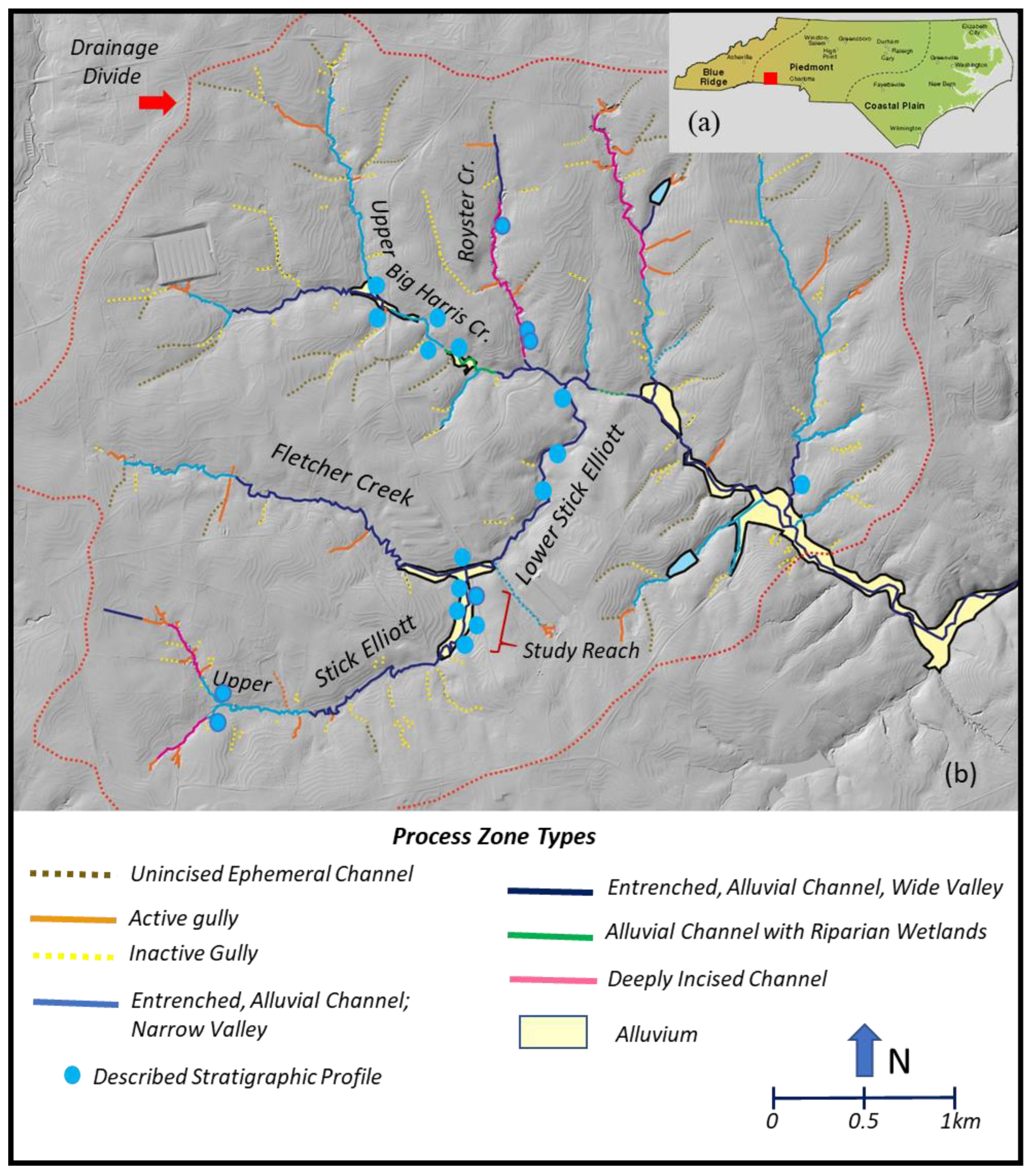
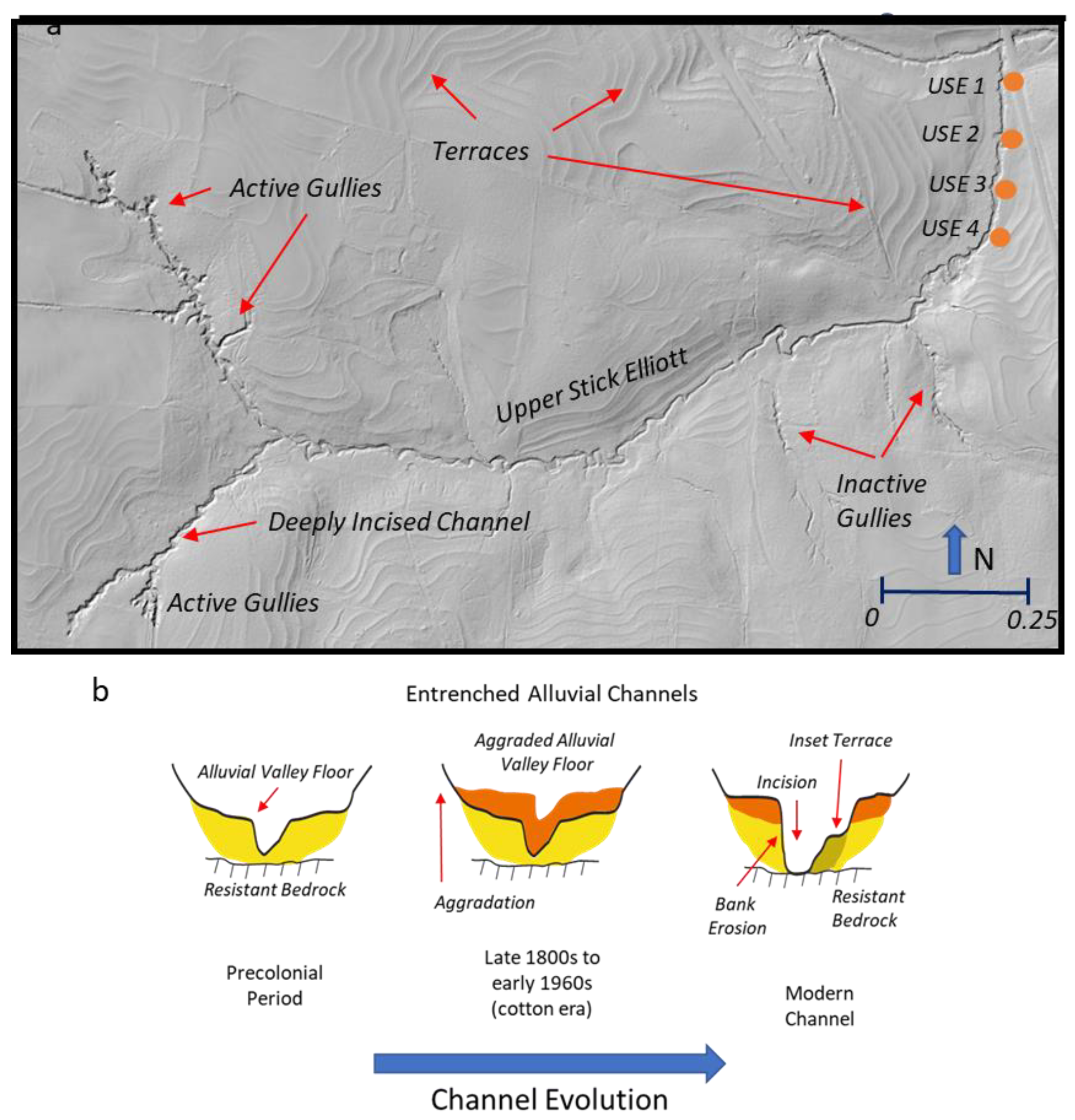

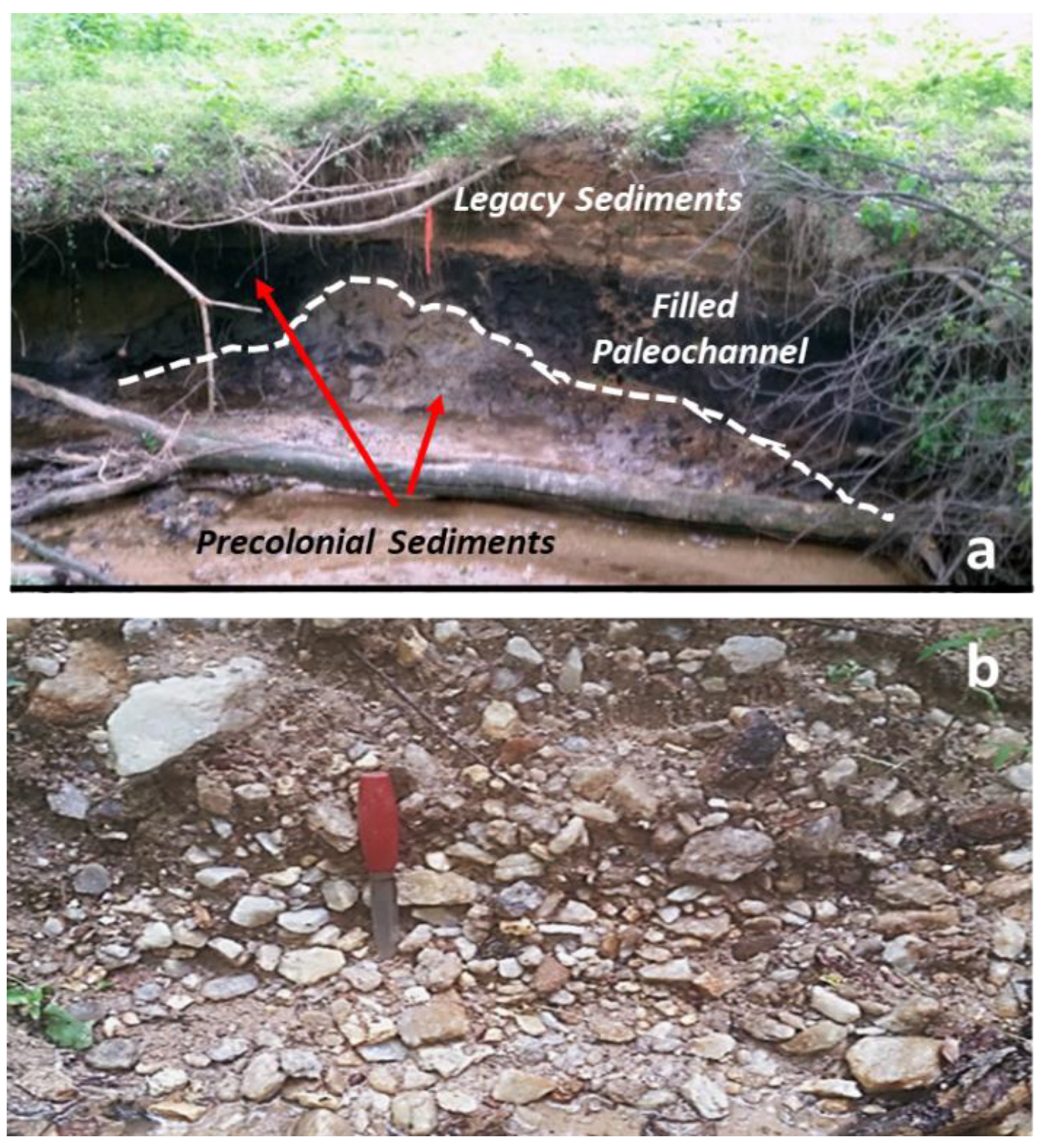
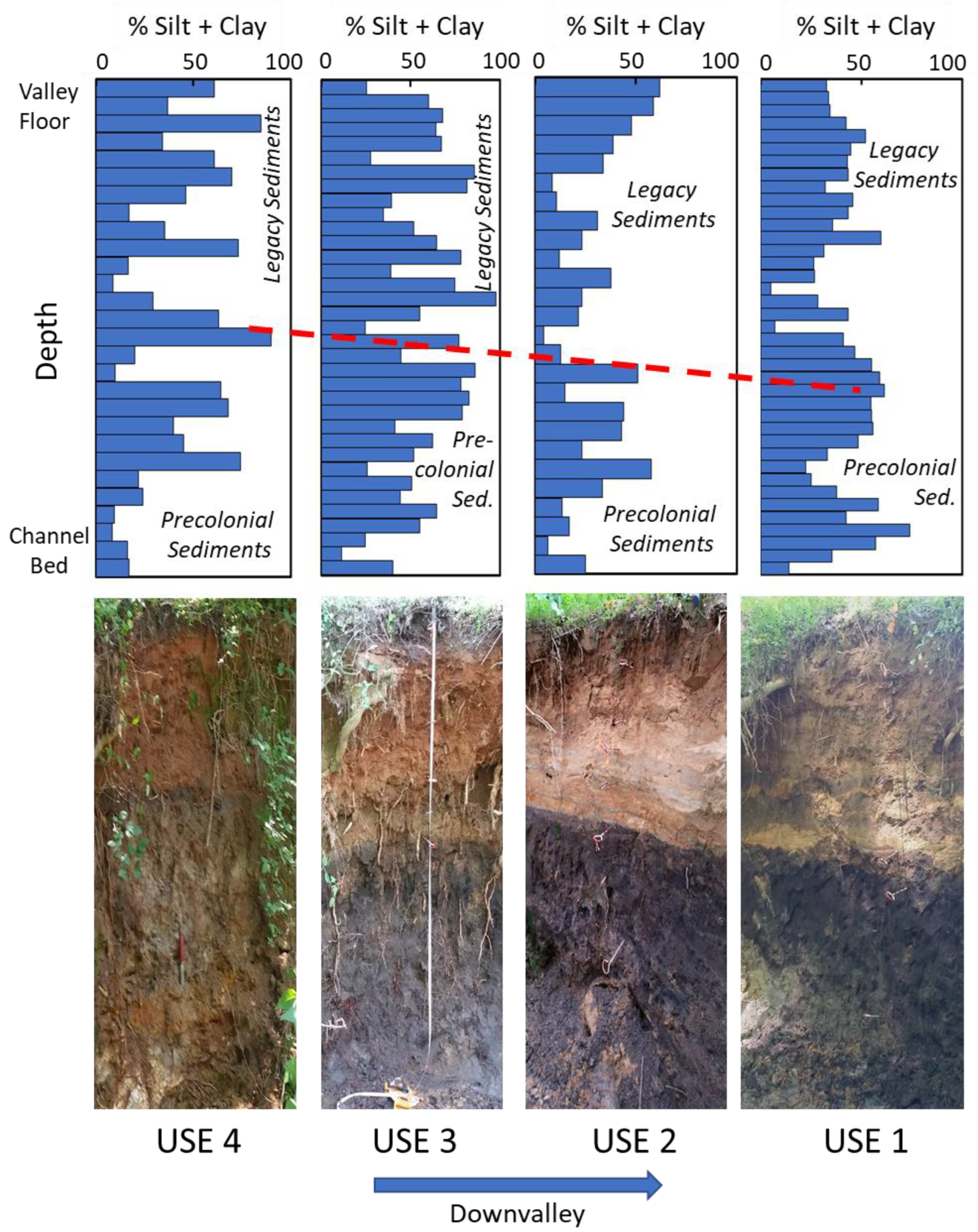
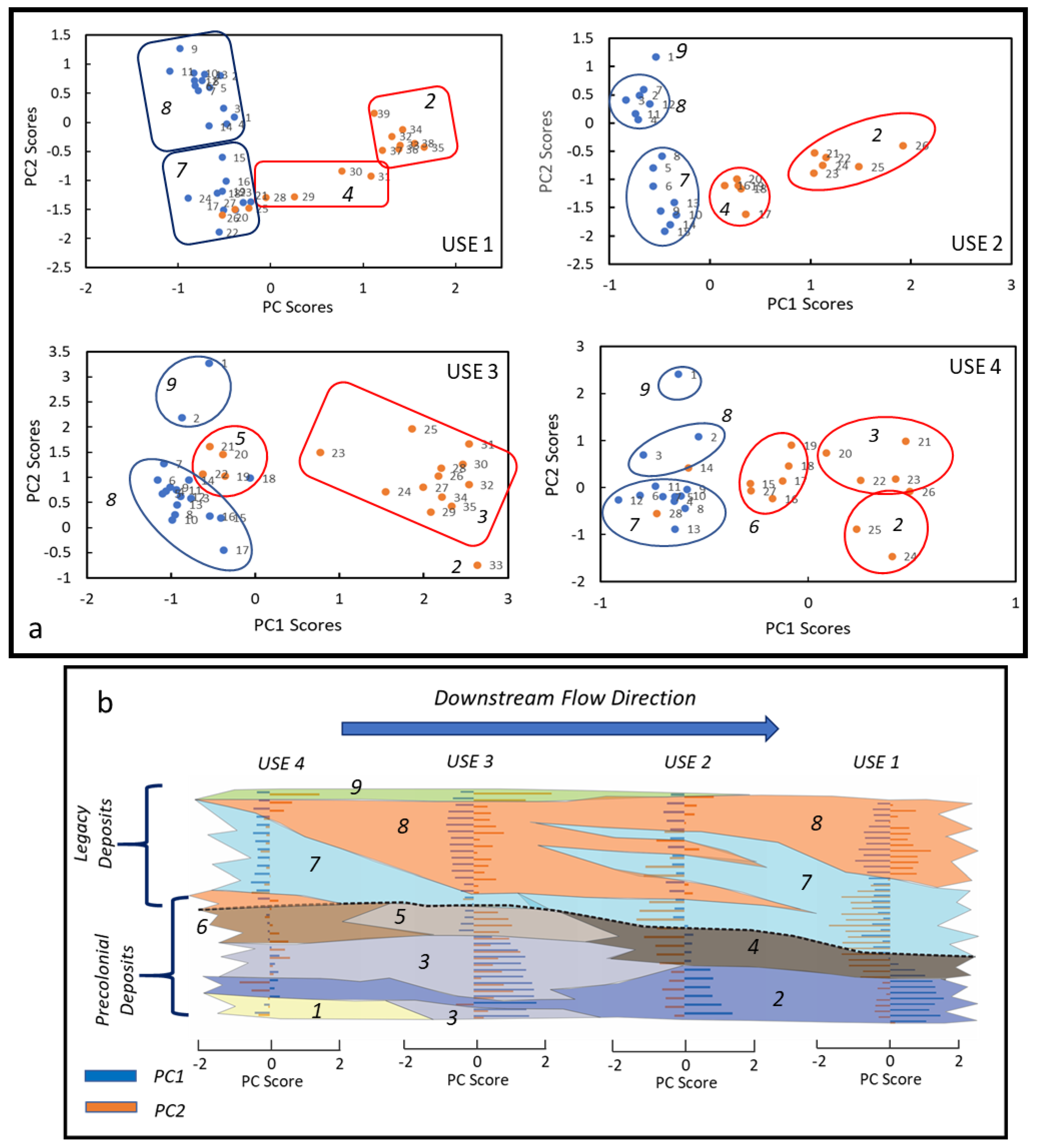
| Co | Cr | Cu | V | W | Zn | Mud a | Al | Fe | Mn | Si | Ti | |
|---|---|---|---|---|---|---|---|---|---|---|---|---|
| Co | 1.00 | |||||||||||
| Cr | 0.51 b | 1.00 | ||||||||||
| Cu | 0.73 b | 0.41 b | 1.00 | |||||||||
| V | 0.62 b | 0.47 b | 0.65 b | 1.00 | . | |||||||
| W | 0.61 b | 0.46 b | 0.53 b | 0.49 b | 1.00 | |||||||
| Zn | 0.59 b | 0.51 b | 0.65 b | 0.61 b | 0.48 b | 1.00 | ||||||
| Mud a | 0.17 b | 0.08 | 0.20 b | 0.22 b | 0.13 c | 0.10 | 1.00 | |||||
| Al | 0.35 b | 0.30 b | 0.35 b | 0.37 b | 0.25 | 0.25 b | 0.22 | 1.00 | ||||
| Fe | 0.85 b | 0.47 b | 0.72 b | 0.57 b | 0.60 b | 0.59 b | 0.10 | 0.31 | 1.00 | |||
| Mn | 0.42 b | 0.30 b | 0.43 b | 0.28 b | 0.20 | 0.47 b | −0.06 | 0.08 | 0.47 b | 1.00 | ||
| Si | −0.33 b | −0.31 b | −0.46 b | −0.49 b | −0.27 | −0.46 b | −0.29 b | −0.29 b | −0.32 b | −0.08 | 1.00 | |
| Ti | 0.47 b | 0.46 b | 0.43 b | 0.52 b | 0.56 b | 0.47 b | 0.21 b | 0.33 b | 0.43 b | 0.16 | −0.25 b | 1.00 |
| Element in Fingerprint | Component | |
|---|---|---|
| PC1 | PC2 | |
| Co | −0.78 | 0.44 |
| Cr | 0.97 | −0.07 |
| Cu | −0.14 | 0.86 |
| V | 0.92 | 0.27 |
| W | 0.94 | −0.08 |
| Zn | 0.61 | 0.59 |
| Unit | Deposit Age | PC1 Scores | PC2 Scores |
|---|---|---|---|
| 1 | Precolonial Sediments | Negative (−0.25 to −0.75) | Negative (−0.05 to −0.55) |
| 2 | Precolonial Sediments | Positive (1.00 to 2.65) | Negative (−0.12 to −0.90) |
| 3 | Precolonial Sediments | Positive (0.76 to 2.60) 1 | Positive (0.30 to 2.00) 1 |
| 4 | Precolonial Sediments | Positive (0.15 to 1.10) | Negative (−0.85 to −1.60) |
| 5 | Precolonial Sediments | Negative (−0.05 to −0.60) | Positive (1.00 to 1.60) |
| 6 | Precolonial Sediments | Negative (−0.12 to 0.28) | Pos./Neg. (−0.25 to 0.15) |
| 7 | Legacy Sediment | Negative (−0.50 to −0.89) 2 | Negative (0.60 to −1.90) 2 |
| 8 | Legacy Sediment | Negative (−0.04 to 1.08) | Positive (0.08 to 1.20) |
| 9 | Legacy Sediment | Negative (−0.55 to −0.89) | Positive (1.08 to 3.27) |
| Predicted Group Membership | ||||
|---|---|---|---|---|
| Strat. Unit | Unit 7 | Unit 8 | Unit 9 | Total |
| Count | ||||
| Unit 7 | 27 | 4 | 0 | 31 |
| Unit 8 | 3 | 31 | 1 | 35 |
| Unit 9 | 0 | 0 | 4 | 4 |
| Percent | ||||
| Unit 7 | 87.1 | 12.9 | 0 | 100 |
| Unit 8 | 8.6 | 88.6 | 2.9 | 100 |
| Unit 9 | 0 | 0 | 100 | 100 |
| Predicted Group Membership | |||||||
|---|---|---|---|---|---|---|---|
| Strat. Unit | Unit 1 | Unit 2 | Unit 3 | Unit 4 | Unit 5 | Unit 6 | Total |
| Count | |||||||
| Unit 1 | 2 | 0 | 0 | 0 | 0 | 0 | 2 |
| Unit 2 | 1 | 16 | 1 | 2 | 0 | 0 | 20 |
| Unit 3 | 3 | 0 | 15 | 0 | 1 | 0 | 19 |
| Unit 4 | 0 | 1 | 0 | 9 | 0 | 0 | 10 |
| Unit 5 | 0 | 0 | 0 | 0 | 4 | 0 | 4 |
| Unit 6 | 0 | 0 | 0 | 0 | 0 | 2 | 2 |
| Percent | |||||||
| Unit 1 | 100 | 0 | 0 | 0 | 0 | 0 | 100 |
| Unit 2 | 5 | 80 | 5 | 10 | 0 | 0 | 100 |
| Unit 3 | 15.8 | 0 | 78.9 | 0 | 5.3 | 0 | 100 |
| Unit 4 | 0 | 10 | 0 | 90 | 0 | 0 | 100 |
| Unit 5 | 0 | 0 | 0 | 0 | 100 | 0 | 100 |
| Unit 6 | 0 | 0 | 0 | 0 | 0 | 100 | 100 |
| Predicted Group Membership | ||||||||||
|---|---|---|---|---|---|---|---|---|---|---|
| Strat. Unit | Unit 1 | Unit 2 | Unit 3 | Unit 4 | Unit 5 | Unit 6 | Unit 7 | Unit 8 | Unit 9 | Total |
| Count | ||||||||||
| Unit 1 | 2 | 0 | 0 | 0 | 0 | 0 | 0 | 0 | 0 | 2 |
| Unit 2 | 0 | 17 | 0 | 0 | 0 | 3 | 0 | 0 | 0 | 20 |
| Unit 3 | 1 | 0 | 12 | 0 | 0 | 6 | 0 | 0 | 0 | 19 |
| Unit 4 | 0 | 0 | 0 | 10 | 0 | 0 | 0 | 0 | 0 | 10 |
| Unit 5 | 0 | 0 | 0 | 0 | 4 | 0 | 0 | 0 | 0 | 4 |
| Unit 6 | 1 | 0 | 0 | 0 | 0 | 1 | 0 | 0 | 0 | 2 |
| Unit 7 | 7 | 0 | 0 | 0 | 0 | 5 | 18 | 1 | 0 | 31 |
| Unit 8 | 1 | 0 | 0 | 0 | 3 | 0 | 2 | 28 | 1 | 35 |
| Unit 9 | 0 | 0 | 0 | 0 | 0 | 0 | 0 | 0 | 4 | 4 |
| Percent | ||||||||||
| Unit 1 | 100 | 0 | 0 | 0 | 0 | 0 | 0 | 0 | 0 | 100 |
| Unit 2 | 0 | 85.0 | 0 | 0 | 0 | 15 | 0 | 0 | 0 | 100 |
| Unit 3 | 5.3 | 0 | 63.2 | 0 | 0 | 31.6 | 0 | 0 | 0 | 100 |
| Unit 4 | 0 | 0 | 0 | 100 | 0 | 0 | 0 | 0 | 0 | 100 |
| Unit 5 | 0 | 0 | 0 | 0 | 100 | 0 | 0 | 0 | 0 | 100 |
| Unit 6 | 50 | 0 | 0 | 0 | 0 | 50 | 0 | 0 | 0 | 100 |
| Unit 7 | 22.6 | 0 | 0 | 0 | 0 | 16.1 | 58.1 | 3.2 | 0 | 100 |
| Unit 8 | 2.9 | 0 | 0 | 0 | 8.6 | 0 | 5.7 | 80 | 2.9 | 100 |
| Unit 9 | 0 | 0 | 0 | 0 | 0 | 0 | 0 | 0 | 100 | 100 |
Publisher’s Note: MDPI stays neutral with regard to jurisdictional claims in published maps and institutional affiliations. |
© 2022 by the authors. Licensee MDPI, Basel, Switzerland. This article is an open access article distributed under the terms and conditions of the Creative Commons Attribution (CC BY) license (https://creativecommons.org/licenses/by/4.0/).
Share and Cite
Sullivan, S.N.; Miller, J.R.; Huffman, C.L. Application of Chemostratigraphic Methods to Floodplain Alluvial Deposits within the Big Harris Creek Basin, North Carolina. Geosciences 2022, 12, 187. https://doi.org/10.3390/geosciences12050187
Sullivan SN, Miller JR, Huffman CL. Application of Chemostratigraphic Methods to Floodplain Alluvial Deposits within the Big Harris Creek Basin, North Carolina. Geosciences. 2022; 12(5):187. https://doi.org/10.3390/geosciences12050187
Chicago/Turabian StyleSullivan, Samantha N., Jerry R. Miller, and Carmen L. Huffman. 2022. "Application of Chemostratigraphic Methods to Floodplain Alluvial Deposits within the Big Harris Creek Basin, North Carolina" Geosciences 12, no. 5: 187. https://doi.org/10.3390/geosciences12050187
APA StyleSullivan, S. N., Miller, J. R., & Huffman, C. L. (2022). Application of Chemostratigraphic Methods to Floodplain Alluvial Deposits within the Big Harris Creek Basin, North Carolina. Geosciences, 12(5), 187. https://doi.org/10.3390/geosciences12050187







